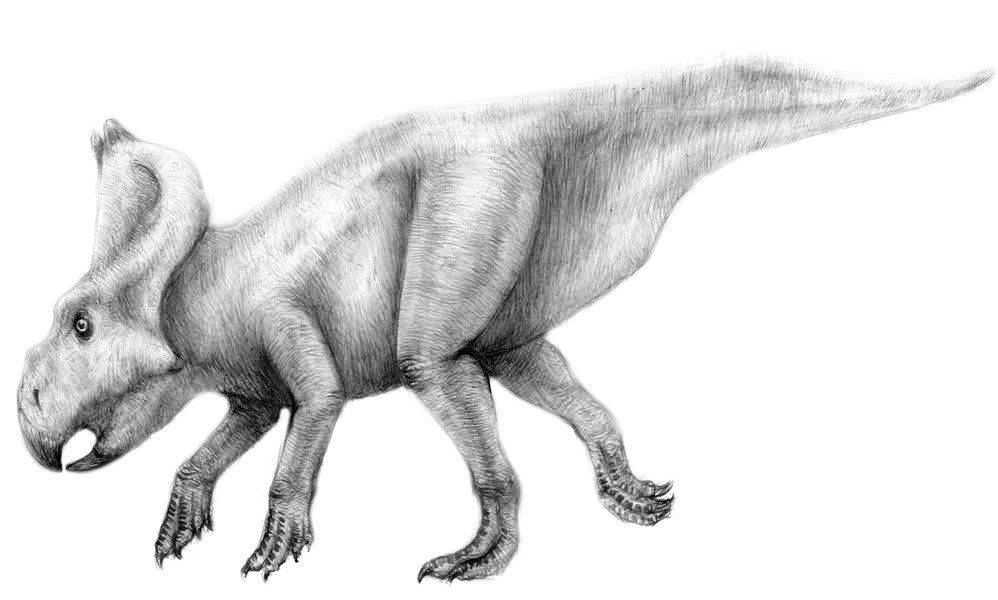Post by Barry the Baryonyx on Jun 27, 2007 20:01:27 GMT -5
Protoceratops multilinguous

Pic Copyright © infoseek
Protoceratops, (its name meaning 'First Horned Face' derived from the Greek proto-/ meaning 'first', cerat-/ meaning 'horn' and -ops/ meaning face) was a sheep-sized (1.5 to 2m long) herbivorous ceratopsian dinosaur, from the Upper Cretaceous Period of what is now Mongolia. Unlike later ceratopsians, it lacked well-developed horns.
Protoceratops had a large neck frill, which may have served to protect the neck, to anchor jaw muscles, to impress other members of the species or combinations of these functions.
Discovery and species
Protoceratops was discovered during the 1920s, in the Gobi desert, in Gansu, Inner Mongolia. Many skeletons were discovered by the American expedition. the type species, P. andrewsi, was formally described by Granger and Gregory in 1923. The fossils date from the Campanian epoch of the Upper Cretaceous (83.5 to 70.6 Million Years Ago).
In 1971, a fossil was found that captured a Velociraptor clutched around a Protoceratops in Mongolia. It is believed that they died simultaneously, while fighting, when they were either surprised by a sand storm or buried when a sand dune collapsed on top of them.
A second species, P. hellenikorhinus, was named in 2001 from the Bayan Mandahu formation in Inner Mongolia, China and also dates from the Campanian epoch of the Upper Cretaceous. It is notably larger than P. andrewsi.
In the 1920s, Roy Chapman Andrews discovered the first known fossilized dinosaur eggs, in the Gobi Desert of Mongolia. Due to the proximity of Protoceratops, these eggs were believed at the time to belong to this species. The nearby theropod Oviraptor was thought to have been engaged in the process of stealing and eating them. However, later discoveries indicate that the eggs were in fact Oviraptor's own.
Copyright © 2006 Answers Corporation

Pic Copyright © infoseek
Protoceratops, (its name meaning 'First Horned Face' derived from the Greek proto-/ meaning 'first', cerat-/ meaning 'horn' and -ops/ meaning face) was a sheep-sized (1.5 to 2m long) herbivorous ceratopsian dinosaur, from the Upper Cretaceous Period of what is now Mongolia. Unlike later ceratopsians, it lacked well-developed horns.
Protoceratops had a large neck frill, which may have served to protect the neck, to anchor jaw muscles, to impress other members of the species or combinations of these functions.
Discovery and species
Protoceratops was discovered during the 1920s, in the Gobi desert, in Gansu, Inner Mongolia. Many skeletons were discovered by the American expedition. the type species, P. andrewsi, was formally described by Granger and Gregory in 1923. The fossils date from the Campanian epoch of the Upper Cretaceous (83.5 to 70.6 Million Years Ago).
In 1971, a fossil was found that captured a Velociraptor clutched around a Protoceratops in Mongolia. It is believed that they died simultaneously, while fighting, when they were either surprised by a sand storm or buried when a sand dune collapsed on top of them.
A second species, P. hellenikorhinus, was named in 2001 from the Bayan Mandahu formation in Inner Mongolia, China and also dates from the Campanian epoch of the Upper Cretaceous. It is notably larger than P. andrewsi.
In the 1920s, Roy Chapman Andrews discovered the first known fossilized dinosaur eggs, in the Gobi Desert of Mongolia. Due to the proximity of Protoceratops, these eggs were believed at the time to belong to this species. The nearby theropod Oviraptor was thought to have been engaged in the process of stealing and eating them. However, later discoveries indicate that the eggs were in fact Oviraptor's own.
Copyright © 2006 Answers Corporation


 Is it just us?
Is it just us?